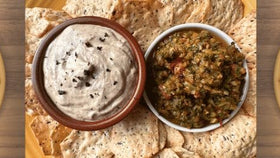Are Nutmeg and Mace the Same?
Though mace blade and nutmeg are parts of the same plant, both even coming from the fruit of that plant, they are two entirely different spices—two separate parts from inside the fruiting body of the nutmeg tree with a different, yet similar, set of flavor properties. Let’s take a look at exactly how nutmeg and mace blade are similar and how they can be set apart.
Why Nutmeg and Mace Blade Are Not Considered the Same Thing:
Mace blade and nutmeg are different parts of the same plant
While mace blade and nutmeg are not exactly the same, they are both sourced from a tropical evergreen tree native to the Spice Islands, the Myristica fragrans. Despite its name, his fruit-bearing tree does not produce nuts, but stone fruit. It is the pit, or seed, of this fruit that is commonly referred to as nutmeg. That seed is not only protected by the fruit itself, but also by a lace-lie covering wrapped tightly around its surface—an aril known as mace blade. Once the fruit is ripe, it will naturally split open to reveal both nutmeg and mace blade.
Mace Blade and Nutmeg are Preserved Differently
Once harvested, exceptional care needs to be taken to separate the nutmeg from the aril surrounding it. There are a few different techniques for doing this: utilizing a knife to gently slice the mace blade at the attachment point and carefully peeling it off of the seed, soaking in water for serval hours prior to gently tearing an edge prior to pushing or squeezing the nut from the aril, or rolling them down hard surface from a height of several feet up. The latter method will not deliver the beautiful, web-like, whole mace blade that is highly desired, however.
Once the blade of mace has been successfully removed from the nutmeg seed they each go through their own distinct process of getting ready for market. The blades are dried in the sun, which takes just a couple of days, and from there they are either marketed as whole mace blade or ground into a powder.
The nutmeg kernel (the portion of the seed used as a spice) still needs to be separated from its outer shell prior to hitting the market, but to do that, it must first be dried. This is also most typically done in the sun, but because they are thicker and lack the airflow created from the lace-like holes in the aril, they must be turned frequently to avoid fermentation or the formation of mold. Depending on conditions, the duration of this process will vary, but usually takes about a week’s time.
Once the nutmeg seed is dried, the shell can be cracked, removed, and discarded. This can be done manually, using a mallet, or a machine. The dense, whole nutmeg is then either sold in its whole form or ground.
If you are curious as to whether you should purchase whole or ground versions of either mace or nutmeg, keep in mind that oils begin to release almost immediately after any spice is ground, so it’s best to keep whole versions on hand and grind them as needed to enjoy the highest potency in flavor.
Nutmeg and mace blade have both similar and different flavor properties
You’re correct, that does sound contradictory. Please allow for elaboration. Because nutmeg and mace blade are derived from the same tree, it only makes sense that they would have very similar flavor characteristics, but they each possess their own unique qualities as well.
Nutmeg is often described as being sweet and intense, whereas mace blade is more frequently described as delicate and spicy. Both are frequently found in recipes alongside cinnamon due to their similar flavor properties. Despite their difference, though, don’t be afraid to substitute one for the other in a pinch. Just be sure to adjust the quantities to accommodate for the varying intensities.
Click here to learn more about the differences between nutmeg and mace blade.







Slofoodgroup
Author